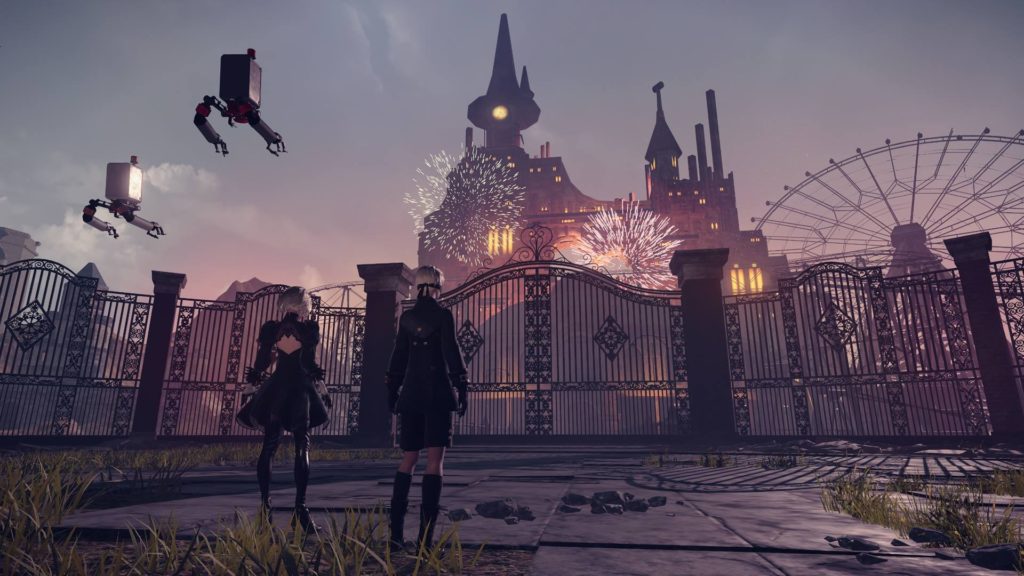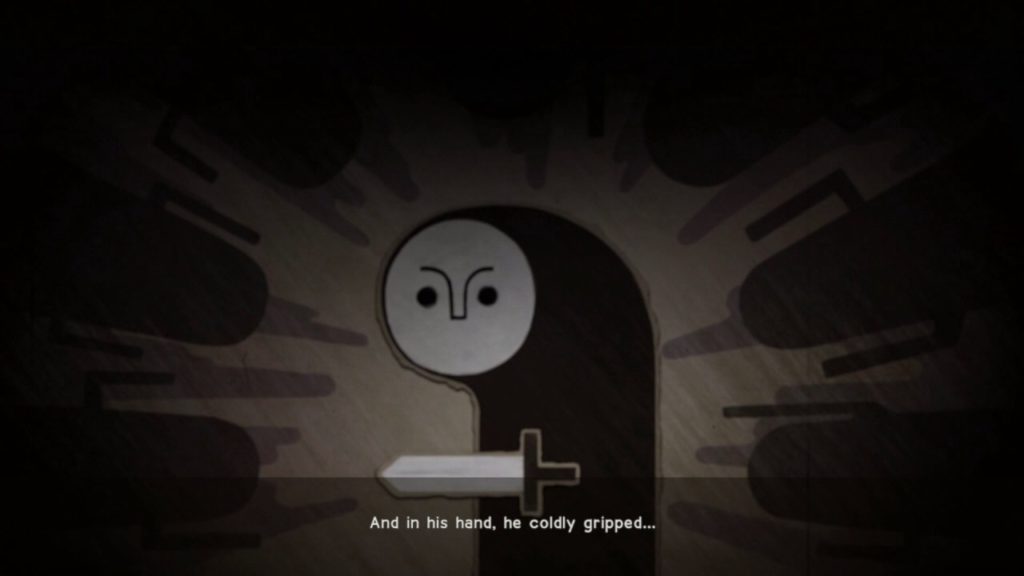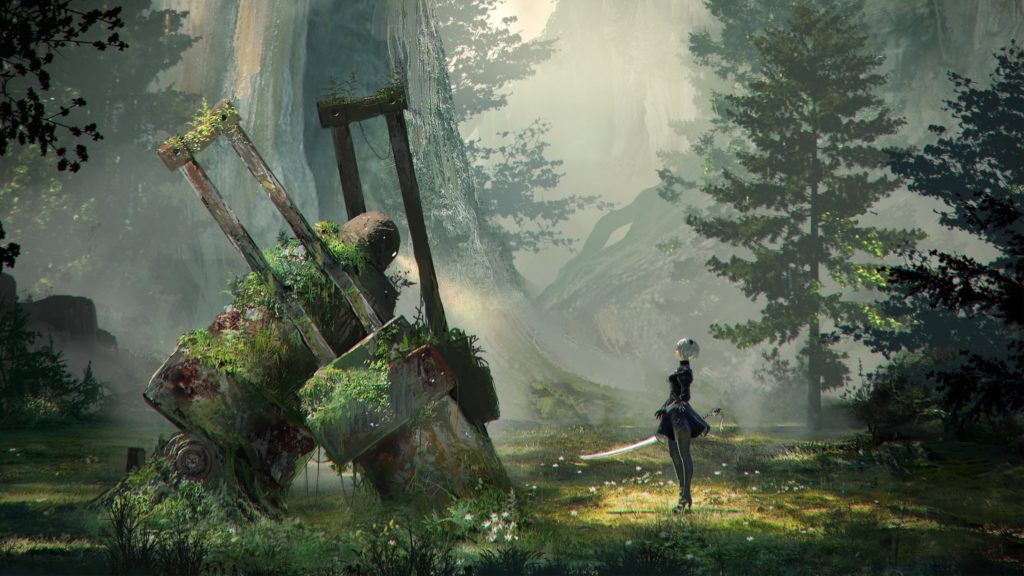Feature Image Art by Albert Urmanov
Although there is no universal criteria for a creation or medium to be considered art, it is generally agreed upon that at the base level, it is a purposeful process of sharing thoughts and ideas meant to evoke reactions in the minds, emotions, or senses of others. Going a step further, I believe art expresses something about our humanity.
All video games are art, and they all require art to create them. As in all art forms, there are truly great works within a specific medium, pieces that become the epitome of their discipline and stand out as truly magnificent.
Nier: Automata is one such work of art. It tells the tragic and poetic story of a specialized group of man-made military androids known as YoRHa. Project YoRHa was developed to turn the tide in a war against machines who were created by aliens that took over the world. Humans make their last refuge on the moon, and non-YoRHa androids who wage a resistance against the machines inhabit the earth. Now the machines are developing new weapons and beginning to mimic human behavior. It might sound basic, but this game is a floating iceberg and that premise simply comprises its tip.
By combining its carefully crafted elements with perfection and exuding a flashy but morbid and minimalist style, Nier: Automata immerses you in a deep and evocative story that sticks long after you’ve put the controller down. It asks big questions and leaves it up to the player to interpret the answers. It’s an intricately layered cerebral and aesthetic masterpiece, perfecting the complete video-game experience, and this is why.
Its Characters
You begin your journey as 2B, a female YoRHa combat unit whose team is tasked with assaulting a machine base. During the initial approach, 2B’s team is quickly decimated by a superior machine weapon. She arrives at the base as the sole survivor, but luckily, a male YoRHa “scanner” unit called 9S tasked with supporting the assault has also survived, and he accompanies the player throughout 2B’s story.
Each character is meticulously crafted using a design that appears deadly yet graceful. Outfits are a Victorian, noir-type mashup perfectly accentuating the YoRHa’s porcelain, doll-like bodies. The costume designs consist of glossy blacks with stark white trimmings, allowing the intricate weavings and etchings on the models to really pop. As an Android, humanity perfected, 2B moves fluidly through the world. By using the right trigger, players can execute a gliding forward dodge that smoothly transitions into a T-1000-esque sprint, shifting into an even faster gear once the character has covered a certain distance. Double-jumping over enemies or onto higher levels feels crisp and precise. The slick, slow-motion dodge system is a combat staple, allowing players to chain together acrobatic dodges that control flawlessly and emphasize the game’s responsiveness.
The androids’ movements during combat are swift and sudden, executing graceful transitions in and out of each attack that put weight behind each strike. To give combat a real sense of flair, 2B will even perform flourishes after certain attacks, spinning a spear above her head or twirling a sword end over end before settling back into a coiled ready position. These tight character animations give the player a superior sense of control and combine with the beautifully crafted texture models to really bring the YoRHa units to life.
But it’s the androids’ personalities and connection to one another that really make them feel alive. 2B and 9S are diametrically opposed, the former meant to be cold, pragmatic, and unquestioning, concerned only with the fulfillment of her duties while 9S is more inquisitive, constantly asking questions and seeking the answers behind plot developments and the machines’ human-like behaviors. Despite their differences, the player witnesses the bond that forms between them throughout the game. They fight together and willingly sacrifice themselves for one another (YoRHa androids can upload their memories to the YoRHa Command Bunker and have them programmed into a new body). Most importantly, they make discoveries throughout the story that help them better understand their own existence and they come to grips with these new realities together.
2B and 9S become connected in a subtly intimate way, and the player comes to not only care about them individually, but about their relationship because you discover that it’s important to the game’s ultimate question: What does it mean to exist?
Its Art Design
Nier: Automata’s world is astounding despite not wowing with cutting-edge graphics, relying on artistic techniques rather than raw power to give players a sense of immersion. The post-apocalyptic City Ruins that serve as the game’s main backdrop use a realistic design that leverages vertical scale and contrasting colors to show players the ruin that is and the city that used to be. Tall, gray concrete structures tower above a landscape overcome with varying green hues of vegetation that’s thrived since the world’s collapse. Faded asphalt marks your path through streets that run between buildings and under collapsed highway overpasses. The omnipresent, smog-colored sky bathes the world in a hazy sepia canvas, reinforcing the bleakness of it all.
Players will also explore other uniquely designed areas throughout their journey. While inside the YoRHa Command Bunker, the game’s circular hub that orbits the moon, the color scheme shifts to black and white and the camera is rotated to a side-scrolling view (a cinematographic technique used in many areas throughout the game). This sapping of color symbolizes the androids’ simplified “black and white” existence and gives the base a programmed, dystopian element. The circular design combined with the 2D camera view creates an ouroboros of sorts, the symbolism of which becomes clear later.
The Abandoned Factory that 2B and her team are sent to assault in the beginning of the game uses a “rust-punk” setting, mixing washed out browns and reds to give off an aging metallic vibe. The Desert area consists of rolling, wind-swept dunes that the player needs to climb and descend like a tugboat navigating through a rough ocean of sand. The Amusement Park is an area that truly stands out, using rich hues of purple, red, blue, and yellow that aren’t as evident in any other areas of the game. It houses a tall, multi-spired epicenter that’s constantly framed in exploding fireworks and displays a hollow, heart-shaped carving in its middle. The entire park is even encircled by an old wooden roller coaster, which players do get to ride.
Enemies typically come in three variants (small, medium, and large) and are uniquely designed based on each area. The basic enemy design uses a classic steampunk theme, but instead of drawing new enemy types from scratch for each area, the basic variants are simply re-skinned and re-armed to fit into the context of their surroundings.
The Amusement Park’s enemies are adorned in carnival-themed outfits that reflect the same rich colors displayed throughout the park. They also wield shiny metal weapons to give them a more “deranged” look, while most other enemies carry crude, machine-made weapons. The Desert machines are meant to look indigenous, wearing painted wooden masks and wrapping themselves in tattered, sun-faded cloaks. In the game’s Forest area, the standard steampunk enemies are adorned with horned helmets and silver-plated armor. They ride wild animals and carry long lances to complement the Forest’s medieval setting, which includes a machine castle that protects a machine king. Bosses and mini-bosses are also designed to fit each area’s theme, the highlight of which is a Godzilla-sized “Leviathan” that players battle in the game’s Flooded City.
You can tell that Platinum Games was strapped when it came to the manpower and resources it had for creating Nier: Automata’s world, but they overcame those obstacles using techniques that allowed the details to shine and create layers of variation in place of big-budget graphics.
Its Narrative
Nier: Automata’s narrative serves as the common thread that stitches the game’s themes together. It ditches long, flashy cutscenes and instead opts to divulge the story in more organic ways. The game doesn’t avoid cutscenes entirely, but they are typically short and don’t get bogged down in long-winded conversations.
The banter between 2B and 9S that builds their personalities assists in telling much of the plot. Each Android is also accompanied by their own AI support pod, which serves as a ranged weapon and provides the character with mission-specific intel and other information critical to the story. Conversations with bosses and the game’s antagonists usually set the stage for delivering the big twists, and items/unlockables found throughout the game world give players further insight into its lore. Dialogue exchanges with NPCs, unless part of the main story, are usually presented only as readable text but are kept short to avoid much of a lull.
Aside from its excellent main narrative, Nier: Automata also delivers meaningful side quests. Completing these missions typically offers the player details about the world and tells the stories of the androids and machines that currently inhabit it, assisting other elements in bringing the game to life. Most side quests are detailed, multi-staged affairs that take unexpected turns and uncover otherwise un-accessed information about the game’s world and the greater narrative. They help build a tangible element to the game’s overarching theme, illustrating the implications of machines mimicking human behavior and exploring the androids’ ultimate tragedy: that they are a juxtaposition, both human and machine, alive yet without true being.
This carefully crafted narrative is also delivered with a minimalist style, using dialogue that carries weight to help support the overall theme, something that’s to be commended in today’s AAA gaming arena. Dialogue is purposeful and poignant, driving the point home using as few words as possible. Powerful lines like “The final screams they summoned on the edge of their death…they still echo within me” are commonplace. One exchange with the game’s main antagonist features an especially barbed question: “You’re thinking about how much you want to **** 2B, aren’t you?” It’s posed via text (no dialogue) and includes the asterisks in place of the profanity. It carries an extreme amount of weight and goes much deeper than meets the eye, which I’ll explain further in the next section.
Not only do most dialogue exchanges and cutscenes matter, but each spoken word is important. There is no filler or fluff, no one-off characters droning on about information completely irrelevant to the world or narrative. This is an important aspect in an age where content is king and most AAA titles contain so much useless filler information that players are skipping dialogue and cutscenes as fast as games will let them.
Its Layers (Warning: Major Plot Spoilers)
Nier: Automata must be beaten in three playthroughs, each of which serves as one of the game’s three acts and introduces another wrinkle to the overall narrative and gameplay.
Players complete the first act as 2B then play through the same act again, but from 9S’s perspective. As 9S, players must adjust to being a support unit as opposed to the more melee-oriented 2B. 9S is weaker in close quarters combat, and as such a new ranged gameplay element called “hacking” is introduced. Initiating hacking will shift players into an Asteroids-like mini-game and creates a whole new combat facet. Act Three continues the game from Acts One and Two’s shared ending and allows players to control A2, a rogue female YoRHa Android introduced as an ancillary character in Act One. A2 can enter a “battle rage” mode that increases her damage output at the expense of depleting health.
This layered approach to the game’s structure keeps players on their toes, and by the time Act Three ends, Nier: Automata seems more like an epic multi-part saga than a single game experience.
The narrative beats also take advantage the game’s multi-part structure, slowly peeling back its many layers across its three playthroughs. During Act One, players discover that the aliens have already been exterminated by their machine creations. The machines are engaging in human behavior because, in the absence of the alien network that once controlled them, they now begin to feel emotions and seek purpose. This explains why they worship the king in the Forest and attempt to establish a god and religion at the end of the first act. In Act Two, 9S learns that humans have also become extinct and humanity’s last bastion on the moon only contains remnants of their DNA.
In the beginning of Act Three, Project YoRHa is revealed as a sham. It’s never meant to succeed but was created instead to perpetuate the war against the machines. Once the YoRHa androids are on the verge of victory, a reset is initiated and the Command Bunker is destroyed by a scripted machine attack, beginning the cycle anew (that ouroboros I mentioned). This is done because all androids are created with the primary instinct and purpose of protecting and serving humans. It is feared if the androids that comprise the resistance on Earth learn of humanity’s fate, they will slip into a deep depression and become extinct themselves. Project YoRHa exists to provide hope that the tide has turned in the war against the machines.
The main characters’ complexity and depths are also revealed through this multi-part structure. During the first act, 2B kills 9S (with 9S’s consent) on multiple occasions. After killing 9S during their most intimate encounter at the end of the first playthrough, she asks “Why does it always have to end like this?” At this time, players are supposed to be confused. But during Act Two, a hacking side quest introduces players to a YoRHa “E” model android. These models are used as assassins that specialize in developing relationships to get close to their targets.
At the end of Act Three, the player learns that 2B’s actual name is 2E. Her and 9S are an inseparable pair meant to complement each other’s tactics. Their teaming is not by happenstance, which is what players are lead to believe until this point. 9S is a scanner model with highly intelligent programming that makes him inquisitive by nature. As part of their partnership, 2B is programmed to kill 9S if his programming leads him to discover the truth about humanity’s fate. His death will then allow Command to wipe his memory before being programmed into a new body.
The comment from the main antagonist in Act Two that asks 9S “You’re thinking about how much you want to **** 2B, aren’t you” now reveals its true depths. Aside from its obvious point that 9S and 2B are developing human-like feelings for one another, this line is important because it reveals that 9S’s affection for 2B is in fact programmed, meant to keep him close to her so she is able to kill him when necessary. This revelation also reveals the symbiotic and utilitarian nature of their relationship.
At the start of Act Three, 2B forces 9S out of fight that would have killed him for good since the Command Bunker has been destroyed (in the cycle that we witness during Nier: Automata, 2B and 9S are the sole survivors of the Bunker’s destruction).
2B is then affected with a logic virus that turns androids and machines alike against one another. 9S may have been able to help had they not been separated during the fighting, but without him, her only option is to retreat to a remote location to avoid spreading the virus to other androids.
During the game’s best cutscene, 2B then encounters A2 (who was on Earth during the Bunker’s destruction) and asks A2 to kill her, therefore containing the virus and ending the cycle of death she inflicts upon 9S. 9S (who doesn’t yet know that 2B is actually 2E) witnesses her death at the hands of A2, and the two surviving YoRHa androids are pitted against each other for the game’s final act. Throughout Act Three, players get a glimpse into 9S’s deteriorating mind, which without 2B there to kill him and erase his memory, is slowly falling apart due to the knowledge of humanity’s demise and the death of his soulmate.
In the end, it’s the YoRHa androids’ AI support pods that achieve true sentience and free will by going against their programming. The AI support pods control Project YoRHa and when the player unlocks the game’s true ending, the pods decide to restart the project, but first, they rebuild 2B, 9S, and A2 with their memories intact simply because they choose to do so because it feels “right.”
Nier: Automata purposefully combines all of these elements to weave a complex and colorful tapestry that transports you into its world and accomplishes what most games fail to do: make you think and feel. The flawless character design complements the game’s slick and responsive combat and makes you feel like a YoRHa android. The art style inserts you into its colorful yet desolate and post-apocalyptic game world, offering subtle glimpses of humanity’s shadow to provide glimmers of hope for the future. The powerful writing style grips you, keeps you engaged, and invests you in the characters and narrative using a multi-faceted plot that develops alongside well-designed side quests and story missions. Finally, the layered approach keeps the experience fresh, enticing you to explore exactly how deep the rabbit hole goes.
Nier: Automata asks big, relevant questions:
What does it mean to exist?
What does it mean to feel?
What are emotions, and where do they come from?
Can we save ourselves from our emotions? Is that the true meaning of existence?
Its greatest achievement as a work of art is not that it asks these questions, but that it makes you feel why contemplating the answers is essential to our humanity.




